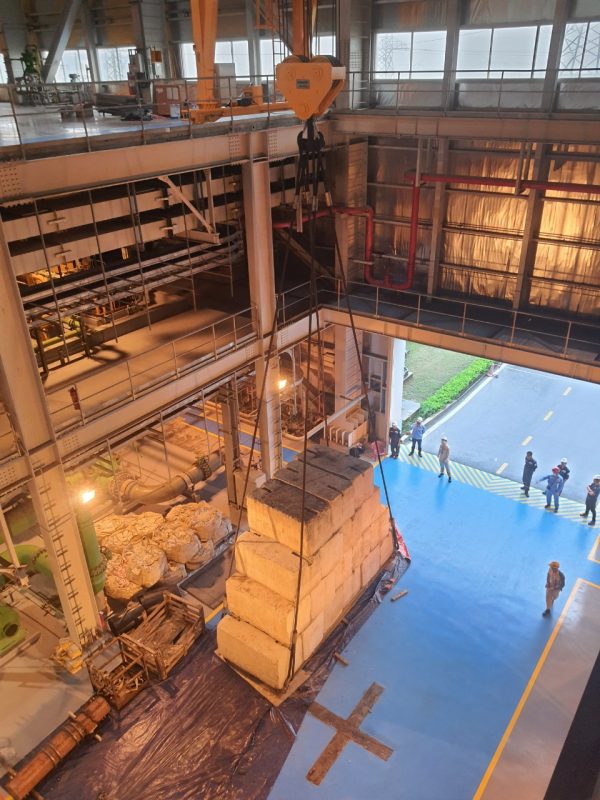Overhead Crane Load Testing is an essential procedure that must be carried out after crane installation and before it is put into operation. It is the final step before the crane is certified and allowed for use.
General Principles
Applicable Standards:
- TCVN 4244-2005: Lifting equipment – Design, manufacture and technical inspection
- TCVN 5206-1990: Lifting and lowering machines – Safety requirements for counterweights and stability
- TCVN 5209-1990: Lifting and lowering machines – Safety requirements for electrical equipment
Test Run and Inspection
The first step after crane installation is to align the mechanisms. Only after the alignment has been deemed reliable should the test run be carried out. Those responsible for the test run include engineers, KCS staff, electricians, workers, crane operators, and safety officers.
The inspection is considered complete when the manufacturer registers with the inspection body and the user inspects it.
Purpose of Inspection
The purpose of the inspection is to measure the technical features, technical parameters, and crane control functions, and to check the load-bearing capacity of the metal structure, which means the accuracy and reliability of the design, manufacture, and installation.
Site Preparation
Inspection of the Entire Crane Before Overhead Crane Load Testing
Electrical Insulation and Grounding Inspection
Working Environment Inspection
Preparation of Load Blocks
The load blocks used for testing must be marked. The load blocks must be prepared according to the following parameters, as an example:
Load (tons) | Load test level | Number (blocks) |
| 6,25 | 125%Q | 1 |
| 5,5 | 110%Q | 1 |
Crane Rail Inspection
Before load testing the crane, the rail surface must be in good condition. The rail tolerance must comply with the relevant standard.
Safety Work
Before load testing, safety work must be well prepared. Firefighting equipment, medical rescue equipment, etc. must be ensured to respond promptly in case of an accident.
Overhead Crane Load Testing
Once all parameters have been set, the first main load test can be performed.
No-Load Test
Operate all mechanisms independently, then operate two mechanisms together, including one-way and two-way movements at all levels of each mechanism.
Each detail on the mechanism must be checked under no-load conditions. Check carefully whether the mechanisms operate smoothly, whether there is any unusual noise, vibration, or looseness, and whether the bearings overheat. Check the reliability of the brakes and the tightness of the bolts.
When the lifting mechanism is unloaded. At each speed, measure the current, and voltage and record the results.
Perform a deformation test, the gaps on the steel structure, and the reliability of the assembly bolts are checked at the same time.
When the no-load test is performed, the hook height and hook reach must be checked and recorded. The effectiveness of the limit switches signals, and alarm devices must be determined.
Static Load Test
The static load test is carried out when the no-load test is completed and the hazards are eliminated, all the faults in the no-load test have been rectified; the purpose of the static load test is to check the crane mechanisms and steel structure.
The test must be carried out when the wind speed is within the allowable working condition.
The static load test is carried out 3 times with an overload of 125%, corresponding to a load of 6.25 tons. (The distance between the two trolleys when testing is not less than 6m).
Conduct a static load test at the slowest speed, and slowest acceleration and without causing load shock, lift the test load about 200-300 mm above the ground and hang the load for 10 minutes. Check the following:
- Check the lifting mechanism brakes and change the reach to ensure the load does not slip.
- There shall not be any cracking in any weld of the metal structure. Residual deformation of steel structures is not allowed. Loosening of bolt joints is not permitted.
The static load test is considered satisfactory if, within 10 minutes of hanging the load, the load does not drift. After lowering the load, the equipment’s mechanisms and parts have no cracks, residual deformation, or other damage.
Note: The load-limiting device must be adjusted accordingly when testing is performed at 125% overload.
Dynamic Load Testing
When all static load test results are consistent, a dynamic load test is performed. Wind strength does not exceed operating wind strength.
– The dynamic load test is performed 3 times, according to the example table below
| Order | Test Load (Tons) |
| 1 | 5,5 |
| 2 | 5,5 |
| 3 | 5,5 |
-Dynamic load testing of the lifting mechanism is performed in the following sequence:
- Up and Down at maximum speed
- When the load is being lowered. Operate the brakes twice, check and ensure the following: The transmission mechanism does not have any abnormal vibrations; Record the motor voltage, current, and lifting speed for different load levels independently in the record.
– Perform dynamic load testing 3 times:
- Record the motor voltage, current, speed, single-way running time, and average running speed.
– Dynamic load testing of the travel mechanism: The travel mechanism travels 3 times, recording the travel speed as well as the voltage and rotation speed of the travel motor.
Dynamic load testing at 110% of the rated load is considered to meet the requirements if, after completing all the above steps, the mechanisms and components of the device operate in accordance with the design specifications, the brakes do not slip, and meet the requirements of the current safety technical regulations, there are no cracks, no residual deformation or other damage.
After the crane load testing is completed and meets the requirements, the crane must be affixed with an inspection stamp and a certificate of use issued by the technical safety inspection agency, and then the crane is allowed to be used.
Thank you for reading this article. Please follow us on our WEBSITE or social media platforms such as FACEBOOK, LINKEDIN, and YOUTUBE for new articles with useful information.
Đọc Thêm: QUY TRÌNH VẬN HÀNH CẦU TRỤC AN TOÀN VÀ HIỆU QUẢ NHẤT
Đọc Thêm: CÁC KỸ HIỆU, CHỈ DẪN TRONG QUÁ TRÌNH VẬN HÀNH CẦU TRỤC

